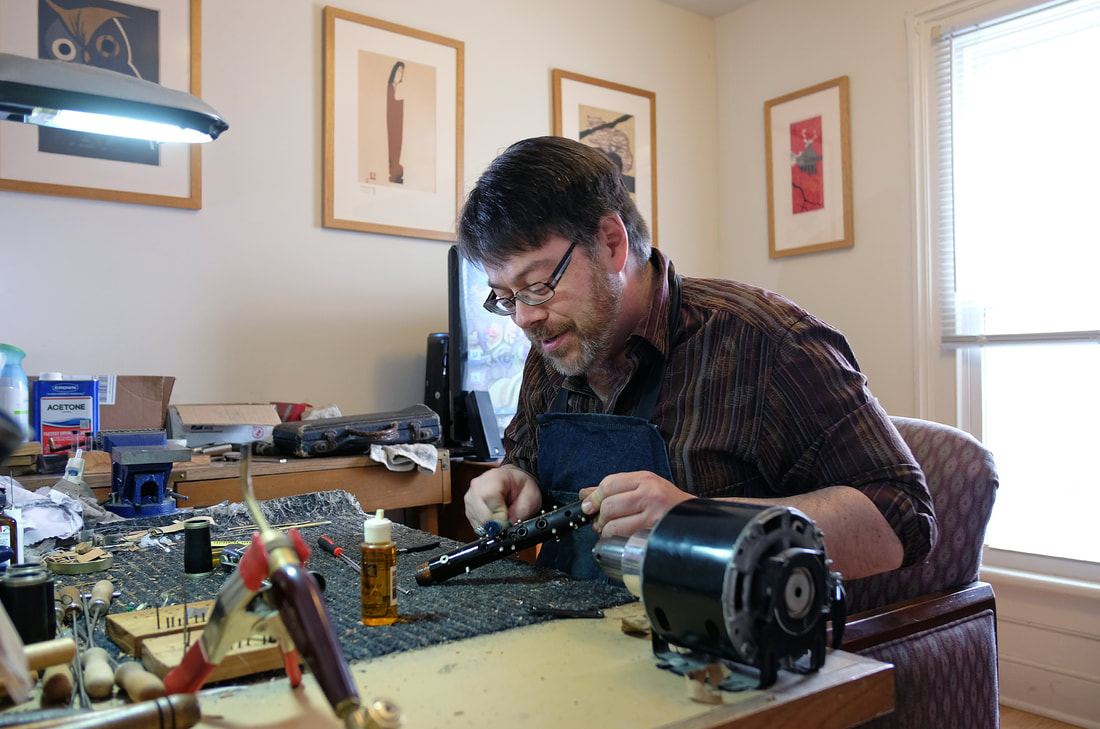 I was buffing this customer clarinet - A c.1900 'Bay State' Albert system in C - when I noticed I'd gone through a layer of black tinting (most likely a colored vanish or shellac) to a lighter color underneath. 'Uh -oh' thinks I, 'now what do I do?' Upon closer examination, I saw that the even layer of black was covering up reddish brown and honey stripes that were far more attractive than the tint, so I kept buffing. What I ended up with was a body that looks like it was carved out of Tiger's Eye, although my picture only gives a hint of its attractiveness! Is this what's under the ebonized tint on modern clarinets, and, if so, why would they cover it up? Or is the modern wood considerably less attractive and covered up for a good reason? This isn't the first time this has happened to me, but I don't have an explanation for it, so I thought I'd post and ask: does anyone know the reason for this? Please click on the pic for a better look, and let me hear from you....
8 Comments
Al
6/23/2013 01:10:24 am
I found an interesting conversation about this topic on the Clarinet BBoard: http://test.woodwind.org/clarinet/BBoard/read.html?f=1&i=40640&t=40640
Reply
jeremy soule
6/23/2013 01:45:19 am
Thanks Al,
Reply
Mykel
11/23/2014 05:52:15 pm
It's not the first time i see old ebony wood looking like this. A guitar repair man tells me that wood crystalise with time, maybe it's a kind of.
Reply
Jeremy, I have a G. Penzel with some beautiful brown hues in one of the sections. The bell used to have the same, but lost the brown after its oil bath during reconditioning. Send m your email address and I will send you some pix. By the way, I have a Jean Barre that plays ok, but could stand to be cleaned, keywork polished, etc. Any idea on cost?
Reply
Al
6/23/2013 06:48:40 am
There's a couple of comments on the Bulletin Board that indicate that very high quality wood used for unstained grenadilla on high end Buffets is generally selected based on its darker color and better consistency. Less expensive wood -- that is, less consistent in terms of color -- is almost always stained because apparently it ain't always pretty.
Reply
6/23/2013 09:33:23 am
Yes, I've puzzled over this too. It has also happened in the piano world: a piano tech friend of mine took his personal Steinway and stripped all the black off it (I think the finish had been damaged) to reveal the mahogany underneath, which he gave a natural oil finish. Boesendorfers have spruce cases: I heard of one with a damaged finish years ago, and fantasized about stripping that down to the bare wood!
Reply
Howard Adamsky
4/9/2014 02:13:21 pm
I believe that some people think a clarinet must be dark black to be considered of quality. the term "African Blackwwod" comes to mind. I have always suspected that the colors under some of the black reveal a beautiful and special clarinet.
Reply
Wyatt
10/23/2014 07:14:42 am
That is the coolest clarinet I have ever seen. I want it so bad.
Reply
Your comment will be posted after it is approved.
Leave a Reply. |
Archives
February 2024
AuthorThe Licorice Shtick Blog is the creation of the Vintage Clarinet Doctor, a Winston Salem, NC based woodwind instrument repair shop specializing in vintage and antique clarinets, saxophones, and the occasional flute. Categories |

 RSS Feed
RSS Feed